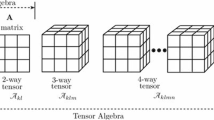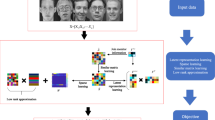Abstract
With the development of feature extraction technique, one sample always can be represented by multiple features which are located in different high-dimensional spaces. Because multiple features can reflect one same sample from various perspectives, there must be compatible and complementary information among the multiple views. Therefore, it’s natural to learn information from multiple views to obtain better performance. However, most multi-view dimension reduction methods cannot handle multiple features from nonlinear space with high dimensions. To address this problem, we propose a novel multi-view dimension reduction method named multi-view reconstructive preserving embedding (MRPE) in this paper. MRPE reconstructs each sample by utilizing its k nearest neighbors. The similarities between each sample and its neighbors are mapped into lower-dimensional space in order to preserve the underlying neighborhood structure of the original manifold. MRPE fully exploits correlations between each sample and its neighbors from multiple views by linear reconstruction. Furthermore, MRPE constructs an optimization problem and derives an iterative procedure to obtain the low-dimensional embedding. Various evaluations based on the applications of document classification, face recognition and image retrieval demonstrate the effectiveness of our proposed approach on multi-view dimension reduction.






Similar content being viewed by others
References
Altman NS (1992) An introduction to kernel and nearest-neighbor nonparametric regression. Am Stat 46(3):175–185
Baskakova LV, Zhuravlev YI (1981) A model of pattern recognition algorithms with representative sets and systems of supporting sets. Zhurnal Vychislitel’noi Mat i Mat Fiz 21(5):1264–1275
Bay H, Tuytelaars T, Van Gool L (2006) Surf: speeded up robust features. In: European conference on computer vision. Springer, Berlin, pp 404–417
Belkin M, Niyogi P (2003) Laplacian eigenmaps for dimensionality reduction and data representation. MIT Press, Cambridge
Bongard MN (1963) Solution to geological problems with support of recognition programs. Sov Geol 6:33–50
Dalal N, Triggs B (2005) Histograms of oriented gradients for human detection. Computer vision and pattern recognition, CVPR 2005. In: Conference on IEEE computer society. IEEE, pp 886–893
De-la-Vega-Doria L, Ruiz-Shulcloper J, Carrasco-Ochoa J (1998) Fuzzy KORA-\(\Omega \) algorithm. In: Proceeding of the sixth european congress on intelligent techniques and soft computing, EFIT’98. Aachen, pp 1190–1194
Dmitriev AN, Zhuravlev YI, Krendeliev FP (1966) About mathematical principles of objects and phenomena classification. Diskretn Anal 7:3–15
Donoho DL, Grimes C (2003) Hessian eigenmaps: locally linear embedding techniques for high-dimensional data. Proc Nat Acad Sci 100(10):5591–5596
Feng L, Wang H, Liu S et al (2015) Locality structured sparsity preserving embedding. Int J Pattern Recognit Artif Intell 29(06):150621203409007
Feng L, Yu L, Zhu H (2017) Spectral embedding-based multiview features fusion for content-based image retrieval. J Electron Imaging 26(5):1
Feng L, Wang H, Jin B et al (2018) Learning a distance metric by balancing KL-divergence for imbalanced datasets. IEEE Trans Syst Man Cybern Syst PP(99):1–12
Gao X, Xiao B, Tao D et al (2008) Image categorization: graph edit distance\(+\) edge direction histogram. Pattern Recognit 41(10):3179–3191
Gorshkov AI, Soloviev AA, Zharkikh YI (2017) A morphostructural zoning of the mountainous crimea and the possible locations of future earthquakes. J Volcanol Seismol 11(6):407–412
Gorshkov AI, Soloviev AA, Zharkikh JI (2018) Recognition of strong earthquake prone areas in the Altai–Sayan–Baikal region. Dokl Earth Sci 479(1):412–414
Hu Q, Wang H, Li T et al (2017) Deep CNNs with spatially weighted pooling for fine-grained car recognition. IEEE Trans Intell Transp Syst 18(99):1–10
Kirnos EA, Pyt ev YP, Djukova EV (2002) Training kora-type algorithms. Pattern Recognit Image Anal 12(1):19–25
Kumar A, Iii HD (2011) A co-training approach for multi-view spectral clustering. In: International conference on machine learning. Omni Press, pp 393–400
Kumar A, Rai P (2011) Co-regularized multi-view spectral clustering. In: International conference on neural information processing systems. Curran Associates Inc., pp 1413–1421
Lian HC, Lu BL (2006) Multi-view, patterns gender classification using local binary, vector support, machines. Adv Neural Netw ISNN 2006:202–209
Liu GH, Li ZY, Zhang L et al (2011) Image retrieval based on micro-structure descriptor. Pattern Recognit 44(9):2123–2133
Liu J, Wang C, Gao J et al (2013) Multi-view clustering via joint nonnegative matrix factorization. In: Proceedings of the 2013 SIAM international conference on data mining. Society for Industrial and Applied Mathematics, pp 252–260
Lowe DG (2002) Object recognition from local scale-invariant features. In: IEEE international conference on computer vision. IEEE, p 1150
MartiNez-Trinidad JF, Guzman-Arenas A (2001) The logical combinatorial approach to pattern recognition, an overview through selected works. Pattern Recognit 34(4):741–751
Nie F, Cai G, Li J et al (2017) Auto-weighted multi-view learning for image clustering and semi-supervised classification. IEEE Trans Image Process 27(3):1501–1511
Nie F, Li J, Li X (2017) Self-weighted multiview clustering with multiple graphs. In: IJCAI, pp 2564–2570
Ojala T, Pietikäinen M, Mäenpää T (2000) Multiresolution gray-scale and rotation invariant texture classification with local binary patterns. IEEE Trans Pattern Anal Mach Intell 24(7):971–987
Oliva A, Torralba A (2001) Modeling the shape of the scene: a holistic representation of the spatial envelope. Int J Comput Vis 42(3):145–175
Roweis ST, Saul LK (2000) Nonlinear dimensionality reduction by locally linear embedding. Science 290(5500):2323–6
Ruiz-Shulcloper J (2008) Pattern recognition with mixed and incomplete data. Pattern Recognit Image Anal 18(4):563–576
Ruiz-Shulcloper J, Lazo-Cortés M (1999) Mathematical algorithms for the supervised classification based on fuzzy partial precedence. Math Comput Modell 29(4):111–119
Ruiz-Shulcloper J, Abidi MA (2002) Logical combinatorial pattern recognition: a review. In: Pandalai SG (ed) Recent research developments in pattern recognition, vol 3. Transword Research Networks, pp 133–176
Saul LK, Roweis ST (2000) An introduction to locally linear embedding. J Mach Learn Res 7:1–13
Sun S (2013) A survey of multi-view machine learning. Neural Comput Appl 23(7–8):2031–2038
Wang Y, Wu L (2018) Multi-view spectral clustering via structured low-rank matrix factorization. IEEE Trans Neural Netw Learn Syst 29:4833–4843
Wang Y, Wu L (2018) Beyond low-rank representations: orthogonal clustering basis reconstruction with optimized graph structure for multi-view spectral clustering. Neural Netw 103:1–8
Wang Y, Lin X, Wu L et al (2015) Robust subspace clustering for multi-view data by exploiting correlation consensus. IEEE Trans Image Process 24(11):3939–3949
Wang H, Feng L, Yu L et al (2016) Multi-view sparsity preserving projection for dimension reduction. Neurocomputing 216:286–295
Wang H, Feng L, Zhang J et al (2016) Semantic discriminative metric learning for image similarity measurement. IEEE Trans Multimed 18(8):1579–1589
Wang Y, Zhang W, Wu L et al (2016) Iterative views agreement: an iterative low-rank based structured optimization method to multi-view spectral clustering. IJCAI 2016:2153–2159
Wang H, Feng L, Meng X et al (2017) Multi-view metric learning based on KL-divergence for similarity measurement. Neurocomputing 238(C):269–276
Wang Y, Zhang W, Wu L, Lin X et al (2017) Unsupervised metric fusion over multiview data by graph random walk-based cross-view diffusion. IEEE Trans Neural Netw Learn Syst 28(1):57–70
Wang M, Hua XS, Yuan X et al (2007) Optimizing multi-graph learning: towards a unified video annotation scheme. In: ACM international conference on multimedia. ACM, pp 862–871
Wold S, Esbensen K, Geladi P (1987) Principal component analysis. Chemom Intell Lab Syst 2(1):37–52
Xia T, Tao D, Mei T et al (2010) Multiview spectral embedding. IEEE Trans Syst Man Cybern Part B 40(6):1438–1446
Xie L, Tao D, Wei H (2016) Multi-view exclusive unsupervised dimension reduction for video-based facial expression recognition. In: IJCAI, pp 2217–2223
Xu C, Tao D, Xu C (2015) Multi-view intact space learning. IEEE Trans Pattern Anal Mach Intell 37(12):2531–2544
Yu L, Feng L, Chen C et al (2016) A novel multi-feature representation of images for heterogeneous IoTs. IEEE Access 4(99):6204–6215
Yu L, Feng L, Wang H et al (2018) Multi-trend binary code descriptor: a novel local texture feature descriptor for image retrieval. SIViP 12(2):247–254
Zhuravlev YI, Nikiforov VV (1971) Recognition algorithms based on computation of estimates. Cybernetics 7(3):387–400
Funding
This work was supported in part by the National Natural Science Foundation of China Grant 61370142, 61802043, 61173163 and 61370200, by the Postdoctoral Science Foundation, No. 3620080307, by the Fundamental Research Funds for the Central Universities Grant 3132016352, by the Fundamental Research of Ministry of Transport of P. R. China Grant 2015329225300, by the Dalian Science and Technology Innovation Fund 2018J12GX037 and Dalian Leading talent Grant, by the Foundation of Liaoning Key Research and Development Program.
Author information
Authors and Affiliations
Corresponding author
Ethics declarations
Conflict of interest
Huibing Wang, Lin Feng, Adong Kong and Bo Jin declare that they have no conflict of interest.
Human participants
This article does not contain any studies with human participants or animals performed by any of the authors.
Additional information
Communicated by V. Loia.
Publisher's Note
Springer Nature remains neutral with regard to jurisdictional claims in published maps and institutional affiliations.
Electronic supplementary material
Below is the link to the electronic supplementary material.
Appendix
Appendix
This appendix shows how to obtain Eqs. 5 from 4 by matrix operations.
where \(Y = [y_1, \dots , y_i, \dots , y_n] \in {\mathbb {R}}^{d \times n} \) is the final low-dimensional representations, \(I_i = [0, \dots , 1, \dots , 0] \in {\mathbb {R}}^{n \times 1}\) is a vector with value 1 of the ith position, and \(W_i^{(v)} \in {\mathbb {R}}^{n \times 1}\) is extended by filling number 0 of the vector \(\sum _j^k w_{ij}^{(v)} \in {\mathbb {R}}^{k \times 1}\).
where \(M^{(v)} = (I-W^{(v)})(I-W^{(v)})^T \in {\mathbb {R}}^{n \times n}\) and \(W^{(v)} = [W_1^{(v)}, \dots , W_n^{(v)}] \in {\mathbb {R}}^{n \times n}\).
Rights and permissions
About this article
Cite this article
Wang, H., Feng, L., Kong, A. et al. Multi-view reconstructive preserving embedding for dimension reduction. Soft Comput 24, 7769–7780 (2020). https://doi.org/10.1007/s00500-019-04395-4
Published:
Issue Date:
DOI: https://doi.org/10.1007/s00500-019-04395-4




